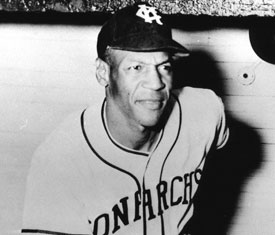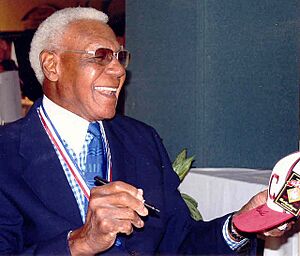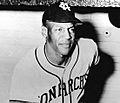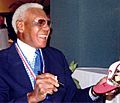Buck O'Neil facts for kids
Quick facts for kids Buck O'Neil |
|||
|---|---|---|---|
 |
|||
| First baseman | |||
| Born: November 13, 1911 Carrabelle, Florida |
|||
| Died: October 6, 2006 (aged 94) Kansas City, Missouri |
|||
|
|||
| debut | |||
| 1937, for the Memphis Red Sox | |||
| Last appearance | |||
| 1955, for the Kansas City Monarchs | |||
| Negro American League statistics | |||
| Batting average | .258 | ||
| Home runs | 9 | ||
| Runs batted in | 175 | ||
| Teams | |||
|
|||
| Career highlights and awards | |||
|
|||
| Induction | 2022 | ||
| Vote | 81.3% | ||
| Election Method | Early Baseball Era Committee | ||
John Jordan "Buck" O'Neil Jr. (born November 13, 1911 – died October 6, 2006) was a famous baseball player and manager. He played mostly as a first baseman for the Kansas City Monarchs in the Negro American League.
After he stopped playing, Buck became a scout for baseball teams. He also made history as the first African American coach in Major League Baseball. Later in his life, he became well-known for his speeches and interviews. He helped many people learn about the history of the Negro leagues. He also played a big part in starting the Negro Leagues Baseball Museum in Kansas City, Missouri. In 2022, he was chosen for the Baseball Hall of Fame.
Buck O'Neil's life story was told in a book called The Soul of Baseball by Joe Posnanski.
Contents
Early Life
Buck O'Neil was born in Carrabelle, Florida. When he was young, he couldn't go to high school because of racial segregation. This meant that Black and white people were kept separate. Florida only had four high schools for African Americans back then.
He grew up in Sarasota, Florida, in a community called Newtown. Buck worked in celery fields, and his father ran a pool hall. Later, he moved to Jacksonville to live with relatives. He went to Edward Waters College, where he finished high school and took college classes.
Baseball Career
In 1934, Buck left Florida to play baseball in "barnstorming" games. These were exhibition games played by teams of different races. His hard work paid off! In 1937, he joined the Memphis Red Sox in the new Negro American League. The next year, he moved to the Kansas City Monarchs.
Buck O'Neil was a great hitter. From 1937 to 1950, his career batting average was .288. This means he got a hit almost three out of every ten times he batted. In 1946, he led the league with a .353 batting average. He also played in three East-West All-Star Games and two Negro World Series.
Buck's baseball career stopped for two years during World War II. He joined the U.S. Navy in 1944 and served in New Jersey. He returned to the Monarchs in 1946.
In 1948, Buck became the manager of the Monarchs. He also kept playing first base until 1951. He managed the team for eight seasons, from 1948 to 1955. During this time, the Negro leagues were becoming smaller. He led the Monarchs to win two league titles.
After Playing Baseball
After his playing days, Buck O'Neil became a scout for the Chicago Cubs in 1956. He is famous for signing Hall of Fame player Lou Brock to his first professional contract.
In 1962, the Cubs made Buck the first African American coach in Major League Baseball. He later became a scout for the Kansas City Royals in 1988. In 1998, he was named "Midwest Scout of the Year."
Buck became very well-known after appearing in Ken Burns' 1994 PBS documentary about baseball. He gave amazing descriptions of the Negro leagues. After that, he was interviewed many times and appeared on popular TV shows.
In 1990, Buck O'Neil helped create the Negro Leagues Baseball Museum (NLBM) in Kansas City. He was the honorary chairman of its board until he passed away. He also received an honorary degree from the University of Missouri – Kansas City.
Buck O'Neil and baseball star Ichiro Suzuki became friends. Ichiro would visit the Negro Leagues Baseball Museum with Buck. He wanted to learn from Buck about the game. Ichiro said, "With Buck, I felt something big. The way he carried himself, you can see and tell and feel he loved this game."
Final Years
In 2006, Buck O'Neil received an honorary doctorate from Missouri Western State University. He also gave the speech at their graduation ceremony.
Buck was part of the Baseball Hall of Fame's Veterans Committee from 1981 to 2000. He helped six Negro league players get into the Hall of Fame. In 2006, Buck himself was nominated for the Hall of Fame. He did not get enough votes that year, but 17 other Negro league players were chosen.
On July 29, 2006, Buck spoke at the Hall of Fame ceremony for the Negro league players. Everyone loved his speech.
Just before the Hall of Fame ceremony, Buck signed a special contract with the Kansas City T-Bones baseball team. This allowed him to play in the Northern League All-Star Game on July 17, 2006. At 94 years old, he was the oldest person to make a plate appearance in a professional baseball game! He walked twice.
The Kansas City T-Bones retired his jersey number on May 26, 2006. In 2021, the team changed its name to the Kansas City Monarchs. This was done to honor Buck O'Neil and the original Monarchs team.
Death and Legacy
Buck O'Neil passed away on October 6, 2006, at the age of 94. He died from heart failure and bone marrow cancer.
The Kansas City Royals baseball team honors Buck O'Neil at every home game. They have a special red seat in Kauffman Stadium called the Buck O'Neil Legacy Seat. A fan who shows Buck's spirit gets to sit in this seat for each game. Buck's brother, Warren G. O'Neil, was the first person to sit there.
Presidential Medal of Freedom
On December 7, 2006, Buck O'Neil was given the Presidential Medal of Freedom by President George W. Bush. This is the highest award a civilian can receive in the United States. He was honored for his "excellence and determination both on and off the baseball field." His brother, Warren, accepted the award for him. Buck joined other baseball heroes like Roberto Clemente and Jackie Robinson who also received this award.
Baseball Hall of Fame
On November 5, 2021, Buck O'Neil was again considered for the Baseball Hall of Fame. On December 5, it was announced that he had been chosen! He was officially inducted on July 24, 2022. His niece, Angela Terry, gave a speech on his behalf.
Other Honors
- Buck O'Neil Lifetime Achievement Award: The Baseball Hall of Fame created an award named after Buck O'Neil. It is given to people who have made great contributions to baseball.
- Statue: In 2008, a life-size statue of Buck O'Neil was placed inside the Negro Leagues Baseball Museum in Kansas City.
- Hall of Famous Missourians: In 2012, Buck was inducted into the Hall of Famous Missourians. A bronze statue of him is on display in the Missouri state capitol building.
- Buck O'Neil Bridge: A bridge in Kansas City, Missouri, is named after him.
- Right on Time Café: A café on the USS Kansas City (LCS-22) ship is named "Right on Time Café," after Buck's autobiography, I Was Right on Time.
Images for kids
-
The Buck O'Neil Legacy Seat at Kauffman Stadium
See also







